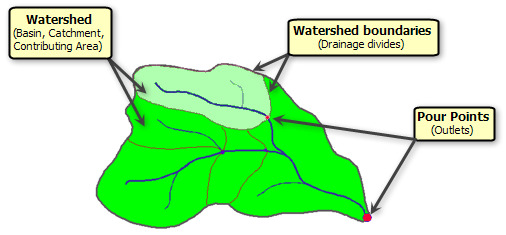Available with Image Server
The area upon which water falls and the network through which it travels to an outlet are referred to as a drainage system. The flow of water through a drainage system is only a subset of what is commonly referred to as the hydrologic cycle, which also includes precipitation, evapotranspiration, and groundwater flow. The hydrology tools focus on the movement of water across a surface.
A drainage basin is an area that drains water and other substances to a common outlet. Other common terms for a drainage basin are watershed, basin, catchment, or contributing area. This area is normally defined as the total area flowing to a given outlet, or pour point.
A pour point is the point at which water flows out of an area. This is usually the lowest point along the boundary of the drainage basin.
The boundary between two basins is referred to as a drainage divide or watershed boundary.

The network through which water travels to the outlet can be visualized as a tree, with the base of the tree being the outlet. The branches of the tree are stream channels. The intersection of two stream channels is referred to as a node or junction. The sections of a stream channel connecting two successive junctions or a junction and the outlet are referred to as stream links.